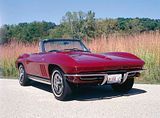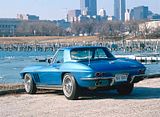| year by year |
1953 - 1962
First generation Corvette...

|
1963 - 1967
Second generation Corvette...

|
1968 - 1982
Third generation Corvette...

|
1984 - 1996
Fourth generation Corvette...

|
1997 - 2004
Fifth generation Corvette...

|
2005 - Present
Sixth generation Corvette...

|
Future
Seventh generation Corvette...

|
 |
|
| |
1965 Corvette
|
For its third season, the 1965 Corvette Sting Ray was not only further cleaned up style-wise, but was muscled up in a big way with the addition of an all-new braking system and beefier powerplants.
Styling alterations to the 1965 were subtle, confined to a smoothed-out hood now devoid of scoop indentations, a trio of working vertical exhaust vents in the front fenders that replaced the previous nonfunctional horizontal "speedlines," restyled wheel covers and rocker-panel moldings, and minor interior trim revisions.
The big news for 1965 was underneath the fiberglass exterior, however. The first welcome addition was the advent of standard four-wheel disc brakes. The brakes had a four-piston design with two-piece calipers and cooling fins for the rotors. Pads were in constant contact with the rotors, but the resulting drag was negligible and didn't affect fuel economy. Further, the light touching kept the rotors clean and didn't diminish pad life, which was, in fact, quite high: a projected 57,000 miles for the front brakes and about twice that distance for the rear binders. Total swept area for the new system was 461 square inches, a notable advance on the 328 square inches of the previous all-drum system. Per pending federal regulation, there was also a dual master cylinder with separate fluid reservoirs for the front and rear lines.
Road testers rightly applauded the all-disc brakes. Testers found that repeated stops from 100 mph produced no deterioration in braking efficiency, and even the most sudden stops were rock-stable. The old drum brakes remained available, however, as a $64.50 credit option, but only 316 of the 23,562 Corvettes built that year came with them.
Another mechanical addition came at midyear, with a new optional V-8. Officially called Mark IV but marketed as the Turbo Jet, the new engine arrived in three varieties: two 396-cid versions, and a 427 (a heavy-duty 427 was also created for marine use). The 396s were scheduled to replace Chevy's hallowed 409 in all its applications for 1965. Future demand for performance cars suggested that Chevy's Tonawanda, New York, engine plant would have to be retooled, and Semon E. "Bunkie" Knudsen, then division general manager, decided that only the most modern engine could justify such a major investment. Mark IV production commenced in mid-1965.
Like the head, the Mark IV block was also new, with 4.84 inches between bore centers, a bore of 4.094 inches, and a stroke of 3.75 inches. The 409 had a deck angled at 33 degrees to allow for wedge-shaped combustion chambers with flat head faces. By contrast, the Mark IV had the usual flat deck sitting perpendicular to the cylinder axis. Main bearings were 2.75 inches in diameter, a quarter-inch larger than those of the 409. Main-bearing width was also increased, adding two full inches to the cap-clamping surface. The forged-steel crankshaft was cross-drilled to deliver oil to the rod bearings through a full 360 degrees of rotation (a feature lacking in the 409). Crankpin journals were kept at a 2.20-inch diameter.
With hydraulic lifters, a four-barrel carburetor, and 10.25:1 compression, the 396 Mark IV offered in intermediate Chevelles and full-size Chevys arrived in two states of tune: 325 and 360 bhp. For the Corvette, the engine was given 11:1 compression, impact-extruded alloy pistons with chrome rings, solid lifters, and a bigger carburetor, all helping to produce 425 bhp. Also on hand were a double-snorkel air cleaner and an oversized oil sump.
Although in short supply at the showrooms, the top Mark IV Corvette wasn't short on performance. Pulling even the moderate 3.70:1 rear axle, it could do standing quarter-miles of around 14 seconds at terminal speeds of 102-104 mph. Given enough road, it would show a top speed of nearly 140 mph. Numerically higher or lower axle ratios would respectively deliver even faster acceleration or higher top speeds (an insane 160 mph was not inconceivable).
Stiffer front springs and sway bar, a special rear sway bar, super-heavy-duty clutch, and a larger radiator and fan were included with the Mark IV option. For instant recognition of the monster at rest, there was an aggressive-looking hood bulge and (as an option) side-mounted exhaust pipes. Though the big-block engine weighed more than 650 pounds, it didn't leave the Sting Ray overly nose-heavy. In fact, weight distribution was a near-perfect 51/49 percent front/rear, a tribute to the foresight of the car's chassis planners.
GM management had initially decreed that no car line smaller than full-size should carry an engine larger than 400 cubic inches. Since the 396 squeaked in under that limit, it replaced the fuel-injected small-block V-8. But with Carroll Shelby installing Ford's impressive 427 V-8 in his sparse two-seater Cobras, Chevrolet felt it would likewise need a 427. It materialized for 1966 -- basically a 396 with a larger 4.25-inch bore.
|

A trio of functional air vents in the front fenders, a smoothed-out hood, and more legible instruments distinguished the 1965 Corvette.

The 1965 Corvette marked the advent of standard four-wheel disc brakes.
|
1965 Corvette Specifications
The 1965 Corvette Sting Ray became ferocious with the mid-year debut of a big-block V-8, the 396 Turbo Jet. The Turbo Jet delivered 425 bhp and a thumping 415 pound-feet of torque. Here are the specifications for the 1965 Corvette Sting Ray:
Vehicle Specifications
|
Convertible
|
Coupe |
Wheelbase, inches
|
98.0
|
98.0 |
Length, inches
|
175.3
|
175.3 |
Width, inches
|
69.6
|
69.6 |
Track, inches
|
front: 56.3 rear: 57.0
|
front: 56.3 rear: 57.0 |
Height, inches
|
49.8
|
49.8 |
Curb weight, pounds
|
3,230
|
3,230 |
Mechanical Specifications (2-door convertible/coupe)
Suspension
front:Independent; upper and lower A-arms, coil springs, antiroll bar, tubular hydraulic shock absorbers
rear: Fixed differential, U-jointed half shafts, lateral struts, radius rods, transverse leaf spring, tubular hydraulic shock absorbers, antiroll bar w/big block engines
Wheels/Tires
7.75x15
Brakes
front: 11.75-inch disc
rear: 11.75-inch disc
Transmission
3-speed manual (std)
4-speed manual (opt)
2-speed Powerglide (opt)
Standard axle ratio
3.36:1
Engine Specifications
| Type |
ohv V-8 |
ohv V-8 |
ohv V-8 |
ohv V-8
|
ohv V-8 |
| Displacement, liters/cu inch |
5.35/327
|
5.35/327 |
5.35/327 |
5.35/327 |
6.5/396 |
| Bore x stroke, inches |
4.00 x 3.25 |
4.00 x 3.25 |
4.00 x 3.25 |
4.00 x 3.25 |
4.25 x 3.76 |
| Fuel Management |
1 x 4-bbl. |
1 x 4-bbl. (AFB)
|
1 x 4-bbl.
|
fuel injection |
1 x 4-bbl. |
| Horsepower @ rpm |
300 @ 5000 |
350 @ 5800 |
365 @ 6200 |
375 @ 6200 |
425 @ 6400 |
| Torque @ rpm, pound-foot |
360 @ 3200 |
360 @ 3600 |
350 @ 4000 |
350 @ 4400 |
415 @ 4000 |
Published Performance Numbers
Acceleration
|
375 hp, 4-sp man.
|
425 hp, 3-sp man. |
0-60 mph, sec
|
6.3
|
5.7 |
0-100 mph, sec
|
14.7
|
13.4 |
1/4-mile, sec @ mph
|
14.4 @ 99
|
14.1 @ 103 |
Vehicle Production and Base Prices
Car Type
|
Production
|
Price |
2-door convertible
|
15,378
|
$4,106.00 |
2-door coupe
|
8,186 |
4,321.00 |
Options and Production
Option
|
Production
|
Price |
Leather Seats
|
2,128
|
$80.70 |
Soft Ray Tinted Glass, all
|
8,752
|
16.15 |
Soft Ray Tinted Glass, windshield
|
7,624
|
10.80 |
| Power Windows |
3,809
|
59.20 |
Auxiliary Hardtop
|
7,787
|
236.75 |
Heater and Defroster Delete (credit)
|
39
|
100.00 |
Air Conditioning
|
2,423
|
421.80 |
Special Front and Rear Suspension
|
975
|
37.70 |
Positraction Rear Axle, all ratios
|
19,965
|
43.05 |
Highway Rear Axle, 3.08:1
|
1,886
|
2.20 |
Power Brakes
|
4,044
|
43.05 |
Drum Brakes (substitution credit)
|
316
|
64.50 |
Transistor Ignition System
|
3,686
|
75.35 |
300 hp Engine
|
8,358
|
53.80 |
365 hp Engine
|
5,011
|
129.15 |
425 hp Engine FI
|
2,157
|
292.70 |
350 hp Engine
|
4,716
|
107.60 |
375 hp Engine FI
|
771
|
538.00 |
| 4-speed Manual Transmission |
21,107
|
188.30 |
Powerglide Automatic Transmission
|
2,468
|
199.10 |
36 Gallon Fuel Tank (coupe)
|
41
|
202.30 |
Off Road Exhaust System
|
2,468
|
37.70 |
Side Mount Exhaust System
|
759
|
|
Teakwood Steering Wheel
|
2,259
|
48.45 |
Teakwood Steering Column
|
3,917
|
43.05 |
Power Steering
|
3,236
|
96.85 |
Cast Aluminum Knock-Off Wheels
|
1,116
|
322.80 |
Blackwall Tires, 7.75 x 15 nylon
|
168
|
15.70 |
| Whitewall Tires, 7.75 x 15 rayon |
19,300
|
31.85 |
| Goldwall Tires, 7.75 x 15 nylon |
989
|
50.05 |
| AM/FM Radio |
22,113
|
203.40 |
Comfort and Convenience Group
|
15,397
|
16.15 |
Color Choices and Production
Color Choice
|
Production |
Color Choice
|
Production |
| Tuxedo Black |
1,191
|
Ermine White |
2,216 |
Nassau Blue
|
6,022
|
Glen Green
|
3,782 |
Milano Maroon
|
2,831
|
Silver Pearl
|
2,552 |
Rally Red
|
3,688
|
Goldwood Yellow
|
1,275 |
|
|
|
|